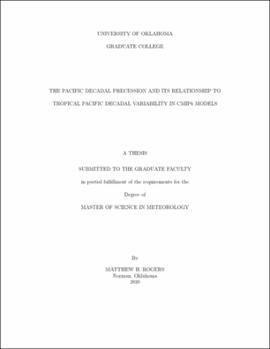| dc.description.abstract | Persistent, multi-year shifts in atmospheric circulations and their associated influence on regional climates can have profound impacts on physical, biological, and socioeconomic systems. The Pacific Decadal Precession (PDP), a quasi-decadal mode of variability in the North Pacific, describes a series of such shifts in atmospheric circulations. Unlike previously established modes of quasi-decadal variability, the PDP is characterized by the cyclonic progression of an atmospheric pressure anomaly dipole around the North Pacific and has been connected to climate variations across North America. The north-south (N-S) oriented phase of the PDP (i.e., when the pressure dipole is oriented meridionally) has been hypothesized to be partially driven by decadal variability in central Pacific (CP) sea surface temperatures given its similarities to the North Pacific Oscillation (NPO). This thesis investigates this hypothesis by identifying connections between the N-S phase of the PDP, the NPO, and tropical Pacific decadal variability (PDV), in both reanalysis and select models from the Coupled Model Intercomparison Project phase 6 (CMIP6) archive. The analyses here show that the N-S phase of the PDP is indeed related to the NPO, as the quasi-decadal temporal evolution of the NPO tracks the PDP well. However, there is a considerable portion of variability in the PDP that is not explained by the NPO which is likely due to the NPO not explaining variability associated with the east-west orientation of the PDP. This thesis also shows that the emergence of the N-S phase is both related to and influenced by tropical Pacific decadal sea surface temperature variability, specifically variability associated with CP El Niño-Southern Oscillation (ENSO) events. The link between the N-S phase of the PDP and CP ENSO events is demonstrated by the similarity in sea surface temperature anomaly patterns associated with both the emergence of the N-S phase of the PDP and the structure of CP ENSO events, and highly significant temporal correlations between the two patterns. In contrast to reanalysis, current climate models struggle with simulating the evolution of the PDP, and in general do not capture the observed relationships between the PDP, the NPO, and tropical PDV. Potential reasons for models not capturing the relationships between the PDP, NPO, and tropical PDV are discussed briefly to motivate future research. While this thesis finds evidence supporting connections between the PDP and other modes of Pacific variability, more understanding of the dynamics of the PDP and how current models simulate it is needed. Establishing a better understanding of the dynamics of the PDP and further assessment of these dynamics in models will aid in improving current prediction capabilities of the PDP and PDP-related regional climate impacts. | en_US |
